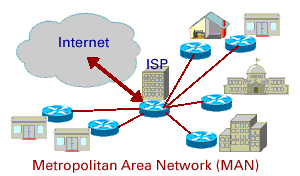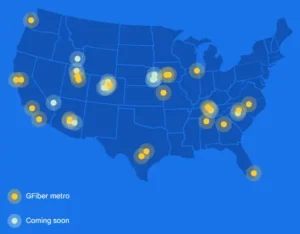Metropolitan Area Networks (MAN) are pivotal in today’s interconnected world, serving as a linchpin between local area networks (LANs) and wide area networks (WANs). They facilitate high-speed connectivity across cities, towns, or large campuses, embodying the technological heartbeat of metropolitan expanses.
This article ventures into the essence of MANs, shedding light on their architecture, operational dynamics, and the modern technologies that underpin their efficiency and security.
Table of Contents:
- What is a Metropolitan Area Network (MAN)?
- Architectural Overview of MANs
- Technologies Behind MAN: Fiber Optics and Beyond
- MAN vs. WAN vs. LAN: Understanding the Differences
- Applications of Metropolitan Area Networks
- Security Challenges and Solutions for MANs
- Future Trends in MAN Technology
- Case Studies: Successful MAN Implementations
- Metropolitan Internet Exchanges
- References

1. What is a Metropolitan Area Network?
A Metropolitan Area Network (MAN) is a specialized network designed to cover a larger geographic area than a LAN but is more contained than a WAN. Typically encompassing a city or a metropolitan area, MANs can interconnect several LANs within this space, facilitating efficient data communication across different locations. Unlike the urban-centric implication of its name, MAN’s scope is defined by its size and scale, not the urbanity of its service area.
Metropolitan Area Network can also have other meanings in different contexts:
- Multiple local area networks (LANs) that are connected on a campus or industrial complex using a high-speed backbone.
- Multiple networks that are connected within the same city to form a citywide network for a specific government or industry.
- Any network bigger than a LAN but smaller than a wide area network (WAN).
- A Distributed Queue Dual Bus architecture network based on the IEEE 802.6 standard of Project 802. This is the formal definition of a metropolitan area network (MAN), but it is essentially obsolete.

2. Architectural Overview of MANs
The architecture of Metropolitan Area Networks (MANs) is a complex framework designed to ensure robust, scalable, and efficient communication across metropolitan areas. At its core, the architecture consists of interconnected Local Area Networks (LANs) through a series of high-capacity backbone technologies, primarily utilizing fiber optic cables for their high-speed data transmission capabilities.
Structural Components
- Backbone Technologies: The backbone of a MAN is made up of high-bandwidth transmission media. Fiber optic cables are the most commonly used due to their ability to transmit large volumes of data over long distances without significant loss of signal quality.
- Dark Fiber Usage: Dark fiber, or unlit fiber cables, are often utilized in the construction of MANs. These are fibers that have been laid but are not currently in use. By leasing dark fiber, organizations can significantly reduce the cost and complexity of establishing their network infrastructure.
- Interconnection Points: MANs are characterized by their interconnection points, where individual LANs converge. These points are equipped with networking hardware like switches and routers that manage data traffic, ensuring efficient routing and data transfer across the network.
Significance of Backbone Technologies
The choice of backbone technology directly impacts the performance, reliability, and scalability of a MAN. Fiber optics offer several advantages, including high transmission speeds, low latency, and resistance to electromagnetic interference, making them ideal for the backbone of a MAN. The deployment of dark fiber also provides a cost-effective solution for rapidly expanding network capacity without the need for extensive new infrastructure.
3. Technologies Behind MAN: Fiber Optics and Beyond
While fiber optics stand as the cornerstone of most MAN architectures, the diversification of technology has introduced alternative methods to establish and enhance MAN connectivity.
Wireless Transmission Methods
- WiMAX: Worldwide Interoperability for Microwave Access (WiMAX) offers a wireless alternative for MAN deployment, providing broadband access over long distances. It is particularly useful in areas where laying fiber optic cables is impractical.
- LTE: Long-Term Evolution (LTE) technology, while commonly associated with mobile telephony, can also be adapted for MAN applications, offering high-speed wireless communication that complements the wired infrastructure.
Digital Subscriber Lines (DSL)
- DSL: This technology uses existing telephone lines to transmit data, providing an alternative means of connectivity for areas within the Metropolitan Area Network. While not as fast as fiber optics, DSL can serve as a cost-effective solution for extending network access to more remote locations within the metropolitan area.
Advantages and Limitations
Each technology brings its own set of advantages and limitations. Fiber optics offer unparalleled bandwidth and speed, but their deployment requires significant infrastructure investment. Wireless technologies like WiMAX and LTE offer flexibility and rapid deployment but face limitations in bandwidth and may be more susceptible to interference. DSL provides wide coverage using existing infrastructure but cannot match the speeds delivered by fiber optics.
4. MAN vs. WAN vs. LAN: Understanding the Differences
Understanding the distinctions between Metropolitan Area Networks (MANs), Wide Area Networks (WANs), and Local Area Networks (LANs) is crucial for grasping the networking ecosystem.
MAN
- Scope: Covers a metropolitan area, bridging the gap between LANs and WANs in terms of geographic coverage and capacity.
- Use Cases: Ideal for connecting multiple offices of a business within a city, educational campuses, or city-wide government networks.
WAN
- Scope: Spans a large geographical area, often interconnecting multiple MANs or LANs across cities, countries, or even continents.
- Use Cases: Used by multinational corporations, government agencies, and as the backbone of the internet to facilitate global connectivity.
LAN
- Scope: Limited to a small geographical area, such as a single building or campus.
- Use Cases: Suitable for home networks, small offices, and specific departments within an organization for internal connectivity and resource sharing.
Complementary Roles
While MANs, WANs, and LANs serve distinct purposes, they complement each other in the broader context of global connectivity. LANs offer high-speed connections in confined spaces, MANs extend this connectivity across larger areas with minimal loss of speed and efficiency, and WANs bridge distant networks, enabling global communication and data exchange.
Understanding these networks’ unique characteristics and applications underscores the importance of a tailored approach to network design and deployment, ensuring each network type is optimized for its specific role in the wider connectivity landscape.
5. Applications of Metropolitan Area Networks
Metropolitan Area Networks (MANs) play a crucial role in the digital infrastructure of modern cities and regions, supporting a wide array of applications that drive connectivity, efficiency, and innovation. Below are key areas where MANs have a significant impact:
Municipal Services and Smart City Initiatives
MANs are foundational to the development of smart cities, enabling the interconnectivity of various municipal services such as traffic management, public safety monitoring, and utility services. By facilitating the seamless exchange of data between different city departments and infrastructure, MANs enhance the efficiency of city operations and improve the quality of life for residents.
Education and Research
Educational institutions and research facilities often span multiple campuses or locations within a metropolitan area. MANs enable these entities to share resources, collaborate on projects, and access centralized databases and applications, significantly enhancing the educational and research capabilities.
Healthcare Networks
MANs support the healthcare sector by connecting hospitals, clinics, and research facilities within a metropolitan area. This connectivity allows for the efficient sharing of patient records, telemedicine services, and access to specialized medical resources, contributing to improved patient care and health outcomes.
Enterprise Connectivity
For businesses operating in multiple locations within a metropolitan area, a MANs network provides the backbone for corporate networks. They facilitate the sharing of resources, collaboration among employees, and access to centralized corporate services, improving operational efficiency and productivity.
Media and Entertainment
MANs support the distribution of digital media content, such as streaming services, broadcasting, and online gaming, by ensuring high-bandwidth connectivity between content providers and users. This supports the growth of the digital entertainment industry and enhances the user experience.
6. Security Challenges and Solutions for MANs
As MANs become increasingly integral to metropolitan infrastructure, the security of these networks is paramount.

Various challenges and solutions characterize the landscape of Metropolitan Area Network security:
Security Challenges
- Distributed Denial-of-Service (DDoS) Attacks: MANs are targets for DDoS attacks, where malicious actors flood the network with traffic to disrupt service.
- Unauthorized Access: The wide-reaching nature of MANs can make them vulnerable to unauthorized access, leading to data breaches and other security incidents.
- Data Interception and Tampering: The transmission of sensitive information over MANs poses the risk of interception and tampering by cybercriminals.
Security Solutions
- Encryption: Implementing end-to-end encryption for data transmitted over MANs ensures that information remains confidential and intact, even if intercepted.
- Firewalls and Intrusion Detection Systems (IDS): Deploying firewalls and IDS at critical points within the MAN helps to block unauthorized access and monitor for suspicious activities.
- Cloud-based Security Services: Utilizing cloud-based security solutions can provide scalable protection against DDoS attacks and other cyber threats. Services like Cloudflare Magic Transit offer network operators the ability to secure their networks while optimizing performance.
- Regular Security Audits and Compliance: Conducting regular security audits and adhering to best practices and standards can help identify vulnerabilities within the MAN and ensure compliance with regulatory requirements.
Proactive Security Management
A proactive approach to security management, including the regular updating of security protocols and the training of personnel in cybersecurity best practices, is essential for maintaining the integrity of the MAN network. By implementing robust security measures and staying vigilant against emerging threats, network operators can safeguard their networks and the critical services they support.
7. Future Trends in MAN Technology
The evolution of Metropolitan Area Networks (MANs) is closely tied to advancements in networking technology, with several key trends poised to significantly influence their development and application:
Integration of 5G
The rollout of 5G technology promises to revolutionize MANs by providing unprecedented speeds and lower latency. This will enhance the capacity of MANs to support a broader range of applications, from ultra-high-definition video streaming to real-time data analytics, thereby opening new avenues for innovation in metropolitan connectivity.
Internet of Things (IoT) Advancements
IoT technology is expanding the scope of MANs beyond traditional computing devices to include a vast array of smart devices and sensors. This integration will facilitate more efficient resource management within metropolitan areas, such as smart lighting, traffic control, and environmental monitoring, contributing to the development of smarter, more connected cities.
Smart City Initiatives
MANs are at the heart of smart city initiatives, providing the infrastructure necessary to interconnect various city services and applications. Future trends include the use of artificial intelligence and machine learning to analyze data collected across the MAN for optimizing city services, enhancing public safety, and improving environmental sustainability.
Enhanced Security Measures
As MANs become increasingly integral to the functioning of metropolitan areas, ensuring their security is paramount. Future trends in Metropolitan Area Network technology will likely include the adoption of more sophisticated cybersecurity measures, such as blockchain for secure, tamper-proof transactions and advanced encryption standards to protect data privacy and integrity.
8. Case Studies: Successful MAN Implementations
Municipal Network: Chattanooga, Tennessee
Chattanooga’s city-owned MAN, known as the “Gig City,” offers residents and businesses internet speeds of up to 10 gigabits per second. This initiative has transformed the city into a hub for innovation and economic development, attracting technology companies and supporting smart city applications such as intelligent traffic management and energy efficiency.

Educational Campus: University of California, San Diego (UCSD)
UCSD’s MAN interconnects the campus’s research facilities, dormitories, and administrative buildings, facilitating seamless access to educational resources, research data, and collaboration tools. This network supports advanced research projects, including high-performance computing and large-scale data analysis, enhancing the university’s research capabilities.
Corporate Setting: Google’s Metropolitan Fiber Networks
Google Fiber, with its deployment in selected cities across the United States, provides an example of a corporate-driven Metropolitan Area Network offering ultra-fast internet services to homes and businesses.

This initiative not only delivers high-speed connectivity but also stimulates competition, leading to improved broadband services and innovation in metropolitan areas.
9. Metropolitan Internet Exchanges
Internet Exchanges (IXs), also known as Exchange Points (XPs), have historically been important for the connection of metropolitan area networks (MANs) to the national or global Internet. The Boston Metropolitan Exchange Point (Boston MXP) enabled metro Ethernet providers, such as the HarvardNet to exchange data with national carriers, such as the Sprint Corporation and AT&T. Exchange points also serve as low-latency link between campus area networks, thus the Massachusetts Institute of Technology and the Boston University could exchange data, voice and video using the Boston MXP.
Cities that host one of the international Internet Exchanges have become a preferred location for companies and data centers. The Amsterdam Internet Exchange (AMS-IX) is the world’s second-largest Internet Exchange and has attracted companies to Amsterdam that are dependent on high-speed internet access. The Amsterdam metropolitan area network has benefited too from high-speed Internet access. Similarly, Frankfurt has become a magnet for data centers of international companies because it hosts the non-profit DE-CIX, the largest Internet Exchange in the world.
10. References
- “Network Warrior” by Gary A. Donahue
- “Computer Networks” by Andrew S. Tanenbaum and David J. Wetherall
- “Fiber Optic Communications: Fundamentals and Applications” by Shiva Kumar and M. Jamal Deen
- RFC 768: “User Datagram Protocol”
- RFC 791: “Internet Protocol”
- Smart Cities: “Big Data, Civic Hackers, and the Quest for a New Utopia” by Anthony M. Townsend